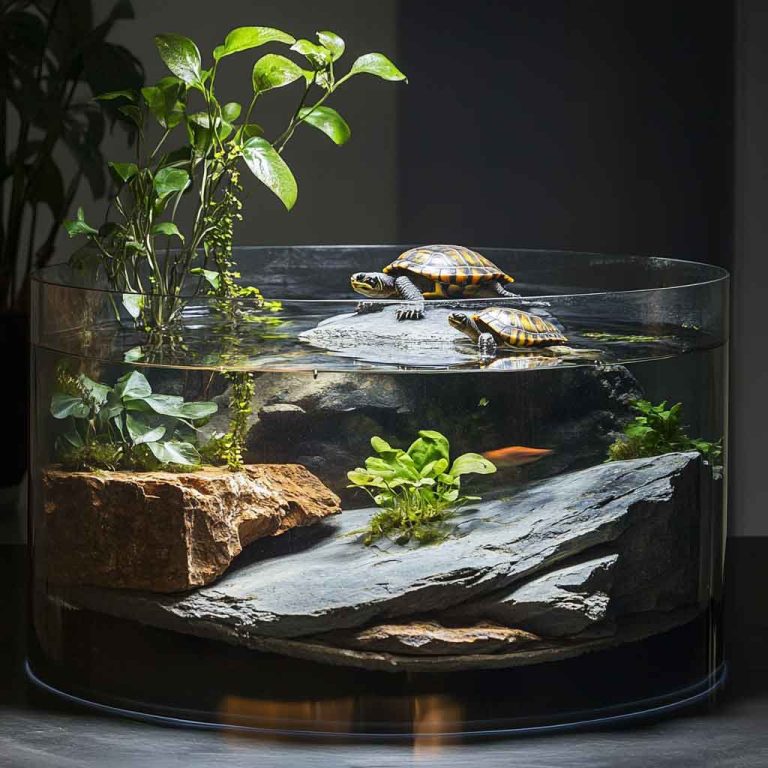Can You Paint a Turtle Shell? Is It Harmful to Turtles?
Turtles are fascinating creatures with their unique, protective shells that serve as both home and armor. As a pet owner or turtle enthusiast, you might wonder if it’s safe to paint a turtle’s shell for aesthetic or identification purposes. This guide explores whether painting a turtle’s shell is possible and, more importantly, if it poses…
Turtles are fascinating creatures with their unique, protective shells that serve as both home and armor. As a pet owner or turtle enthusiast, you might wonder if it’s safe to paint a turtle’s shell for aesthetic or identification purposes. This guide explores whether painting a turtle’s shell is possible and, more importantly, if it poses any harm to these remarkable reptiles.
Can you paint a turtle’s shell? While it is physically possible to apply paint to a turtle’s shell, it is generally not recommended. Painting a turtle’s shell can potentially harm the turtle by interfering with its health, shell function, and natural behaviors.
This article delves into the risks associated with painting a turtle’s shell, why the shell is critical to a turtle’s well-being, and safer alternatives for identifying or decorating your turtle. Let’s explore the details to ensure the best care for your shelled friend.
Is It Safe to Paint a Turtle’s Shell?
Painting a turtle’s shell might seem like a harmless or creative idea, but it can have serious consequences for the turtle’s health. The shell is not just an external covering; it’s a living part of the turtle’s body, made of bone and covered with keratin scutes. These scutes protect the underlying bone and help regulate the turtle’s temperature and health.
Applying paint to the shell can disrupt these vital functions. Most paints, even those labeled as non-toxic, can contain chemicals that may seep into the shell or be absorbed through the turtle’s skin, leading to toxicity or irritation. Additionally, paint can block sunlight, which turtles need to synthesize vitamin D3 for healthy bone and shell development.
Here are some key risks associated with painting a turtle’s shell:

Potential Risks of Painting a Turtle’s Shell:
1. Toxicity and Chemical Exposure
Paints, including acrylics or nail polish, often contain volatile organic compounds (VOCs) or other chemicals that can be harmful if absorbed. Turtles may also ingest paint particles while grooming or eating, leading to internal toxicity. Even non-toxic paints may not be safe for turtles, as their biology differs from humans or other animals.
2. Impaired Thermoregulation
A turtle’s shell plays a critical role in regulating body temperature. Paint can alter the shell’s ability to absorb or reflect heat, potentially causing overheating or insufficient warmth. This is especially problematic for aquatic turtles that rely on basking to maintain their body temperature.
3. Blocked UV Light Absorption
Turtles need exposure to ultraviolet (UV) light to produce vitamin D3, which is essential for calcium metabolism and shell health. Paint can block UV rays from penetrating the shell, leading to deficiencies that cause shell deformities or metabolic bone disease.
4. Shell Damage and Infections
Paint can trap moisture or bacteria against the shell, creating an environment conducive to fungal or bacterial infections. Over time, this can weaken the shell or cause shell rot, a serious condition that requires veterinary intervention.
Why Is the Turtle’s Shell So Important?
The turtle’s shell is far more than a decorative feature; it’s an integral part of its anatomy and survival. Understanding the shell’s role can help clarify why painting it is risky. The shell consists of two main parts: the carapace (the upper part) and the plastron (the lower part). These are made of bone fused with the turtle’s spine and ribs, covered by keratin scutes that grow and shed naturally over time.
Here’s why the shell is critical to a turtle’s well-being:
Key Functions of the Turtle’s Shell:
1. Protection
The shell acts as a shield against predators and environmental hazards. It’s tough enough to withstand significant impact, but it’s also sensitive to changes like chemical exposure or physical damage from paint.
2. Thermoregulation
As ectothermic animals, turtles rely on their environment to regulate body temperature. The shell absorbs heat during basking, helping the turtle maintain an optimal internal temperature. Any coating, like paint, can disrupt this process.
3. Health Indicator
A healthy shell is smooth, firm, and free of cracks or discoloration. Changes in the shell’s appearance can signal underlying health issues, such as poor diet or infection. Painting the shell can mask these signs, delaying necessary veterinary care.
4. Growth and Development
The shell grows with the turtle, and the scutes shed periodically to accommodate this growth. Paint can interfere with the natural shedding process, potentially causing abnormal growth or shell deformities.
Because the shell is a living, breathing part of the turtle, any alteration—like painting—can have long-term consequences for its health and survival.
Are There Safe Ways to Paint or Decorate a Turtle’s Shell?
Given the risks, painting a turtle’s shell is not a safe practice. However, if you need to identify your turtle (e.g., for tracking in a multi-turtle enclosure) or want to add a decorative touch, there are safer alternatives that prioritize the turtle’s health.

Safe Alternatives to Painting:
1. Non-Toxic, Water-Soluble Markers
For temporary identification, veterinarians sometimes use non-toxic, water-soluble markers designed for animal use. These markers are applied sparingly and wear off naturally without harming the turtle. Always consult a vet before using any product on your turtle.
2. Shell-Safe Identification Tags
Small, lightweight tags or bands can be attached to the shell’s edge by a professional. These are often used in research or conservation settings and are designed to avoid interfering with the turtle’s movement or shell health.
3. Natural Shell Patterns
Many turtles have unique shell patterns that can be used for identification. Photographing and documenting these natural markings is a non-invasive way to distinguish individual turtles.
4. Decorative Tank Accessories
Instead of altering the turtle’s shell, consider decorating its enclosure with colorful rocks, plants, or basking platforms. This allows for creative expression without risking the turtle’s health.
FAQs About Painting a Turtle’s Shell
1. Can I use non-toxic paint on my turtle’s shell?
Even non-toxic paints can be harmful to turtles. These paints may still contain chemicals that can be absorbed through the shell or skin, leading to toxicity or irritation. They can also block UV light and disrupt thermoregulation, so it’s best to avoid painting altogether.
2. Why do some people paint turtle shells?
Some people paint turtle shells for aesthetic reasons, to mark turtles for identification, or for events like turtle races. However, this practice is discouraged by veterinarians and turtle care experts due to the potential health risks it poses to the turtle.
3. What should I do if I’ve already painted my turtle’s shell?
If you’ve painted your turtle’s shell, act quickly to minimize harm. Gently clean the shell with lukewarm water and a soft cloth to remove as much paint as possible, avoiding harsh chemicals or scrubbing that could damage the shell. Consult a veterinarian immediately to assess your turtle’s health and ensure no lasting damage has occurred.
4. Can painting a turtle’s shell kill it?
While painting a turtle’s shell may not immediately kill the turtle, it can lead to serious health issues over time, such as toxicity, infections, or metabolic bone disease. These conditions can significantly shorten the turtle’s lifespan if left untreated.
Final Word
Painting a turtle’s shell may seem like a fun or creative idea, but it’s generally harmful and should be avoided. The shell is a vital, living part of the turtle’s body, essential for protection, thermoregulation, and overall health. Applying paint can lead to toxicity, infections, and other health issues that compromise the turtle’s well-being.
Instead of painting, opt for safer alternatives like non-toxic markers or natural shell patterns for identification, or enhance your turtle’s enclosure for aesthetic appeal. Always prioritize your turtle’s health by consulting a veterinarian before applying any substances to its shell. By understanding and respecting the importance of the turtle’s shell, you can ensure your pet lives a long, healthy, and happy life.







